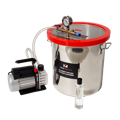
Keeping your thermoplastics dry is the first step to a successful print -- without it, none of your settings, adjustments, or troubleshooting will help.
With just an oven, drying can take 12-32 hours -- Using our kit is the fastest, most consistent, and most effective way to dry that we've found -- from our shop to yours!
Generally, you can dry PEEK in 4-10 hours, and with a single vacuum pull, you're good to go.
Essentially, this is an issue only because we are melting plastic, and extruding it at temperatures above the boiling point of water.
When plastic is melted with moisture inside, the water molecules turn to steam, and create popping noises, and visible gaps or bubbles during the printing process. Absorbed moisture has been shown to act as a plasticizer, reducing the glass transition temperature and strength of plastic – which is a reversible effect.
This causes a ‘loosening’ of the molecular attraction which causes a reduction in mechanical properties and an increase in fluidity. The equilibrium moisture content (EMC) of a hygroscopic material surrounded at least partially by air is the moisture content at which the material is neither gaining nor losing moisture.
The value of the EMC depends on the material and the relative humidity and temperature of the air with which it is in contact.Because of all this, with almost all the high-performance filaments, like PEEK, PEI, PPSU, and PPS, the filament must be dried before processing (extruding)
Bake the filament spool at 120ºC for 12 hours, in a convection-style oven (toaster oven, conventional, lab or vacuum oven)
Use a pressure chamber to immediately pull -30 inHg of vacuum on the spool, immediately after baking, while still hot, and vacuum for about 1 minute at -30 inHg (full vacuum), or -1 bar, while agitating spool inside chamber(move it around, give it motion -- this activates moisture molecules and boils them off in the vacuum).
Next, move the spool to the chamber, and include desiccant in the chamber to absorb any extra moisture from the air. These materials soak up moisture very quickly (in minutes -- not hours). An advanced option is to run a line of Nitrogen or Argon into the filament chamber, maintaining slight positive pressure, forcing all oxygen/moisture out of the chamber. This allows for the longest print times.

| Material | Drying temp* | Drying time** | Max moisture content |
|---|---|---|---|
| PLA | 65-90°C | 4-12 hrs | 250 ppm |
| ABS | 80-90°C | 2-4 hrs | 200 ppm |
| PCTG | 65-70°C | 4-8 hrs | 600 ppm |
| TPU A | 80-90°C | 2-3 hrs | 200 ppm |
| TPU D | 90-120°C | 2-3 hrs | 200 ppm |
| HTN | 110-110°C | 6-8 hrs | 400 ppm |
| PA 12 | 80°C | 4-8 hrs | 1000 ppm |
| PACF | 100-120°C | 4-8 hrs | 500 ppm |
| PC | 120°C | 3-5 hrs | 200 ppm |
| Essentium 9085 | 110-120°C | 4-6 hrs | 200 ppm |
| PEEK | 120°C | 3-6 hrs | 200 ppm |
| PEKK | 120°C | 3-8 hrs | 200 ppm |
| PPS | 120°C | 2-4 hrs | 100 ppm |
| PESU | 120°C | 3-4 hrs | 200 ppm |
| PETCF | 90°C | 6-8 hrs | NA |
| PPCF | 70°C | 2-4 hrs | 200 ppm |
* These temperatures are intended for a dehumidified hot air dryer, using air with a dew point below -40°C.
** The table shows estimated drying times based on common industry practices for different materials. If a spool has only absorbed a small amount of moisture, it can be dried more quickly, while more moisture requires longer drying times and higher temperatures. Materials like polyamides, polysulfones, TPU, PEI, and PVA are very sensitive to moisture and may need even longer drying times if they reach their maximum moisture capacity. To avoid issues, it's best to keep these materials dry and prevent them from absorbing too much moisture.When over-dried for long periods of time (generally days, weeks, or months) polymers can become brittle, so be careful not to over-dry.